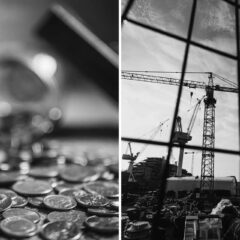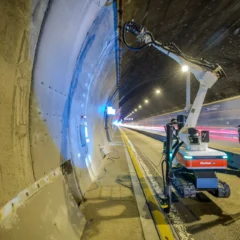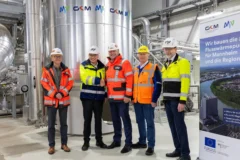
Lars Redtzer, Head of Industry Development at Construction Companies. Image: Construction Companies. Robo-dog Buster. Image: Peab AB
The desire to evolve, enhance expertise, build with better quality, and
reduce climate impact are issues that today rank high on the agenda for
most construction companies. This is the view of Lars Redtzer, Head of
Industry Development at the Construction Companies, who sits on the
committee for SBUF, the Swedish Construction Industry’s Development
Fund.
For over 40 years, SBUF has financed development and research projects that have contributed to increased knowledge in the construction industry. SBUF provides project grants to companies that are members of the commissioning entities Construction Companies and the Installation Companies.
“The focus areas for construction companies, which we work a lot with, are climate, skills development, and healthy competition. The agenda also includes productivity development for construction companies and our members. I see that there is a natural drive among companies to want to develop, and right now, climate issues are high on the agenda,” says Lars Redtzer.
What drives the desire within climate issues?
“It’s the competition and the client’s demands, but it’s also about construction companies wanting to positively drive society forward in climate issues.”
Many questions about climate
According to Lars Redtzer, there’s a great deal of innovation among construction companies to find solutions for reducing the industry’s climate emissions. “There are many questions regarding climate management, and by transforming data, one can track the impact construction has on society and where the construction material is used so it can be recycled. This means that digital twins and surely AI in some way both now and in the future can be useful,” he continues.
“And when we start using new technology and materials, like green concrete or fossil-free steel, and leverage the possibilities of digitalization through, for example, digital twins and AI, we can find solutions and execute projects to continue reducing the construction industry’s impact on the climate.”
What’s currently hot in terms of digitalization?
“We’re conducting and calculating climate calculations which we then transform with the help of environmental data and make available to everyone.”
Strategic innovation programs
Lars Redtzer further explains that construction companies are working with strategic innovation programs, an initiative where leading players from the business sector, academia, and public sector themselves identify and define areas where they see a need for concerted efforts and joint initiatives.
“We work together with innovation programs like Smart Build focusing on digitalization, and within infrastructure, we work with InfraSweden, an innovation program for a smart, sustainable, and competitive transport infrastructure,” he says.
What challenges does the construction industry face today?
“There’s a huge desire to build with higher quality and make fewer mistakes. But then we need to find a format and be open to change. There’s a drive in the industry to increase competitiveness, find opportunities to develop their products and improve. Furthermore, there are demands when it comes to climate and reducing total emissions, and with better products, we can reduce them,” says Lars Redtzer
List of innovation projects:
Circular services promoting the reuse market in the installation industry
The installation industry needs to increase circular material flows to create sustainable buildings and installations. Increased reuse in the industry requires new standards and collaborations with other actors within the construction sector. This action plan, nominated for the innovation of the year 2024, presents the findings.
STAR – Temperature crack data for climate-improved concrete
The project presents the material data the industry needs for the future. Here, AMA Anläggning 23 EBE.11 has adjusted the requirements for climate-improved concrete, regarding limiting the risk of temperature-related cracking. Nominated for innovation of the year 2024.
RBK method for RF measurement in floor leveling
The project provides a new agreed measurement method for moisture measurement of concrete in construction projects. The RBK system has been supplemented and also includes a further developed measurement methodology for RF determination in floor leveling. Nominated for innovation of the year 2024.
Measuring energy at construction sites
The project is a large industry-wide collaboration within the network LÅGAN, with participation from 13 actors that has now led to a large measurement study, granted by SBUF and the Swedish Energy Agency’s research program E2B2. The measurement study will increase knowledge about energy use at construction sites. In the project, the measurement plan is applied and developed at 12 construction sites. The goal is to increase knowledge about what affects energy use for different items at construction sites and phases in the building process.
Robodog Buster prevents construction errors
The sight of robo-dog Buster autonomously navigating a construction site is no
cause for surprise. Buster is part of an SBUF-funded development project that
Peab is running together with the Centre for Construction Robotics at Lund University of Technology. Buster’s mission is to ensure the construction
progresses smoothly.
New measurement method for automated quality control of our roads
Awarded innovation of the year 2022, it is an industry-developing project that
provides work safety for the people and productivity increase for the companies
and reduces the risk of traffic disruptions.






 Myrna Whitaker
Myrna Whitaker  Nils Lund
Nils Lund  Anna Broberg
Anna Broberg 